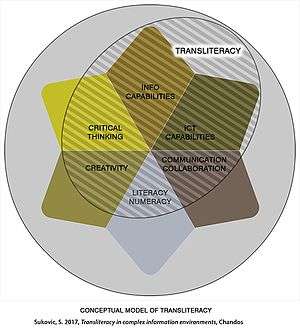Transliteracy
Transliteracy as a concept refers to 'a fluidity of movement across a range of technologies, media and contexts'.[1] A more detailed definition is the following: 'Transliteracy is an ability to use diverse analog and digital technologies, techniques, modes, and protocols to search for and work with a variety of resources; to collaborate and participate in social networks; and to communicate meanings and new knowledge by using different tones, genres, modalities, and media. Transliteracy consists of skills, knowledge, thinking, and acting, which enable fluid "movement across" in a way that is defined by situational, social, cultural, and technological contexts'.[2]
Transliteracy combines a range of capabilities required to move across a range of contexts, media, technologies and genres. Conceptually, transliteracy is situated across five capabilities: information capabilities (see information literacy), ICT (information and communication technologies), communication and collaboration, creativity and critical thinking. It is underpinned by literacy and numeracy.[1] (See figure below)

History
While the term appears to come from the prefix 'trans-' (across) and the word 'literacy', the scholars who coined it say they developed it from the practice of transliteration, which means to use the letters of one language to write down a different language.
The concept of transliteracy was first developed in 2005 by the Transliteracies Research Project,[4] directed by University of California at Santa Barbara professor Alan Liu. The concept of 'transliteracies' was developed as part of research into online reading. It was shared and refined at Transliteracies conference, held at UC Santa Barbara in 2005. The conference inspired De Montfort University professor Sue Thomas to create the Production in Research and Transliteracy (PART) group, which evolved into the Transliteracy Research Group, The current meaning of transliteracy was defined in the group's seminal paper Transliteracy: crossing divides. The concept was enthusiastically adopted by a number of professional groups, notably in the library and information field. Transliteracy Research Group Archive 2006-2013 curates numerous resources from this period.[5]
For a number of years, there was a gap between significant interest in transliteracy among professional groups and the scarcity of research. A group of academics from the University of Bordeaux considered transliteracy mainly in the school context,[6][7][8][9] Thomas studied transliteracy and creativity[10] and Sukovic researched transliteracy in relation to digital storytelling.[11] The first book on the topic, Transliteracy in complex information environment by Suzana Sukovic, is based on research and experience with practice-based projects.[2]
Relationship to other terms
Related terms are "media and information literacy", "information literacy", "digital literacy", "multiliteracies" and "metaliteracy". Transliteracy is a unifying framework rather than a replacement of existing literacies. It considers "movement across" which requires a range of capabilities.
See also
References
- 1 2 "What Exactly Is Transliteracy? | SciTech Connect". scitechconnect.elsevier.com. Retrieved 2017-03-18.
- 1 2 Sukovic, Suzana. "Transliteracy in Complex Information Environments - 1st Edition, p.8". www.elsevier.com. Retrieved 2017-03-06.
- ↑ Suzana,, Sukovic,. Transliteracy in complex information environments. ISBN 9780081009017. OCLC 966557085.
- ↑ "Transliteracies » Research Project". transliteracies.english.ucsb.edu. Retrieved 2017-03-06.
- ↑ "Transliteracy Research Group Archive 2006-2013". Transliteracy Research Group Archive 2006-2013. Retrieved 2017-03-06.
- ↑ Anne, Cordier,; Anne, Lehmans, (2012-07-01). "Distance Learning as a Central Issue for the Learning and Professionalization Process of Professeurs Documentalistes: The French Synthesis of Transliteracy". School Libraries Worldwide. 18 (2). ISSN 1023-9391.
- ↑ Liquète, Vincent (2012-06-01). "Can one speak of an "Information Transliteracy"?". International Conference : Media and Information Literacy for knowledge societies. Moscou, Russia: 7 p.
- ↑ Lehmans, Anne; Cordier, Anne (2014-10-20). Kurbanoğlu, Serap; Špiranec, Sonja; Grassian, Esther; Mizrachi, Diane; Catts, Ralph, eds. Information Literacy. Lifelong Learning and Digital Citizenship in the 21st Century. Communications in Computer and Information Science. Springer International Publishing. pp. 118–127. doi:10.1007/978-3-319-14136-7_13. ISBN 9783319141350.
- ↑ Lehmans, Anne; Mazurier, Valentine (2015-06-01). "Transfer, transformation, transition: What the School Library can do in Transliteracy, the French Context". 44 th international association of school librariansip international conference. Maastricht, Netherlands: IASL: 312–323.
- ↑ Thomas, Sue (2013-09-01). "Making a space: transliteracy and creativity". Digital Creativity. 24 (3): 182–190. doi:10.1080/14626268.2013.806332. ISSN 1462-6268.
- ↑ Sukovic, Suzana (2014-09-18). "iTell: Transliteracy and Digital Storytelling". Australian Academic & Research Libraries. 45 (3): 205–229. doi:10.1080/00048623.2014.951114.
External links
- Transliteracies Research Project, University of California Santa Barbara
- Transliteracy Research Group (static site)
- Transliteracies Conference, UCSB, July 2005
- Libraries and Transliteracy Blog
- Transliteracy: the art and craft of moving across (Part 1, Suzana Sukovic)
- What exactly is transliteracy? (Part 2, Suzana Sukovic)
- Transliteracy palettes: developing capabilities for moving across (Part 3, Suzana Sukovic)
- Academic city of villages (Part 4, Suzana Sukovic)